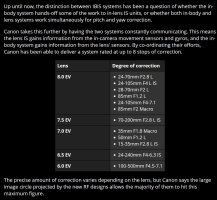I know that rating cameras and lenses with stabilization to a certain number of stops of effectiveness is kind of a dubious pseudoscience to begin with. But there are a lot of wild claims going around about how many stops the IBIS claims to provide.
In the unveiling video, 8 stops was mentioned repeatedly, but I assumed anywhere near this would only be achieved when using a lens that also had stabilization. But this video offhandedly mentions that the 50mm f1.2 should provide 7 stops, and the 28-70mm f2 should provide 8 stops because of the "image circle" of those lenses, even though those lenses do not have IS. I assume they mean the image circle is large enough to allow the sensor a lot of room to move. (Link goes right to the spot in the video that mentions this.)
Claiming anything higher than 5 stops of stabilization with IBIS only and no IS in the lens sounds to me like something between overly ambitious and flat-out unheard of. Could the IBIS really be this good?
In the unveiling video, 8 stops was mentioned repeatedly, but I assumed anywhere near this would only be achieved when using a lens that also had stabilization. But this video offhandedly mentions that the 50mm f1.2 should provide 7 stops, and the 28-70mm f2 should provide 8 stops because of the "image circle" of those lenses, even though those lenses do not have IS. I assume they mean the image circle is large enough to allow the sensor a lot of room to move. (Link goes right to the spot in the video that mentions this.)
Claiming anything higher than 5 stops of stabilization with IBIS only and no IS in the lens sounds to me like something between overly ambitious and flat-out unheard of. Could the IBIS really be this good?

